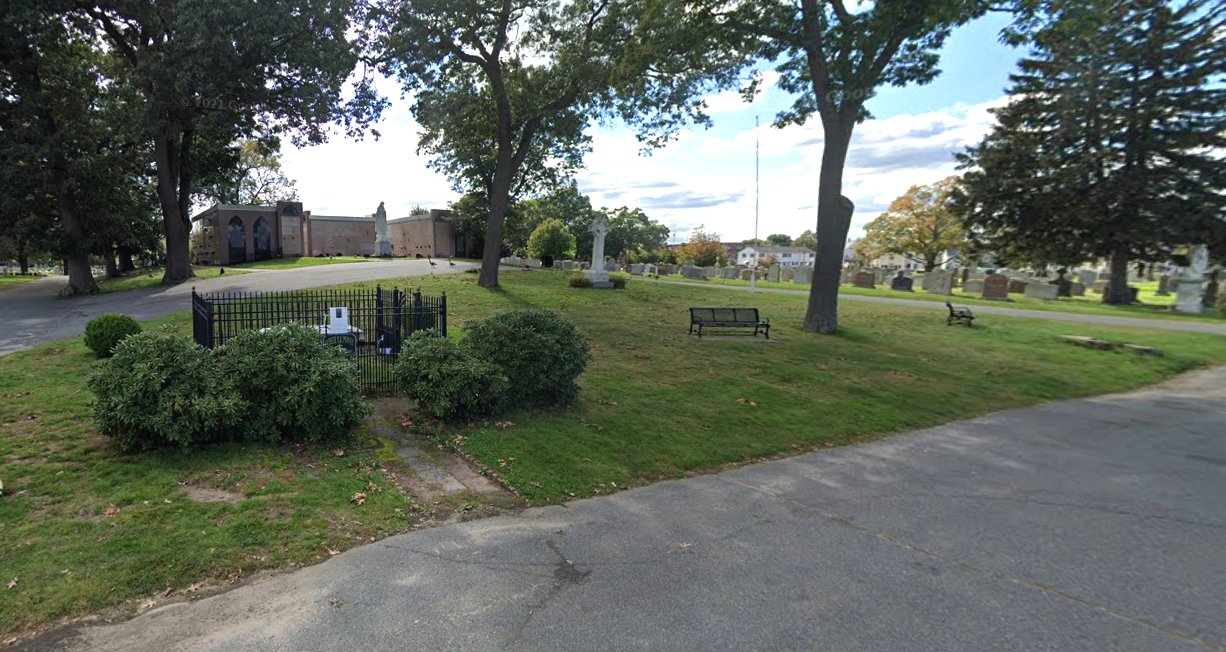Patrick Power was born in Bantry, Ireland, the youngest child of Patrick Power and Mary Sullivan.
He was baptised in Bantry Catholic Parish on 20 October 1844. The Baptismal Sponsors were Jerh Regan and Honora Murphy. His baptism was on the Feast of the Maternity of the Blessed Virgin. (Last on image)
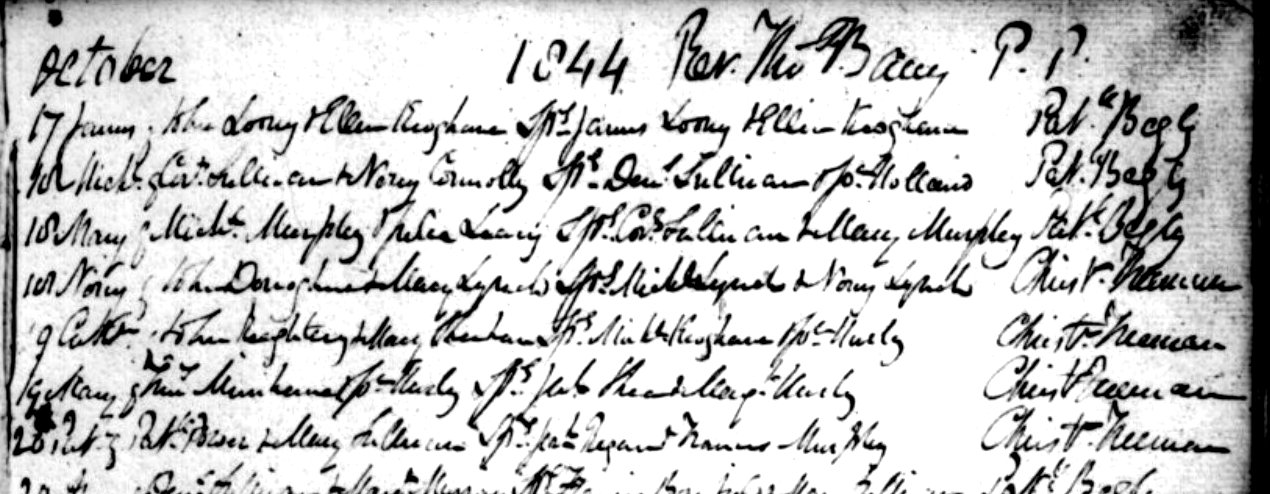
Below is the typed entry on irishgenealogy.ie
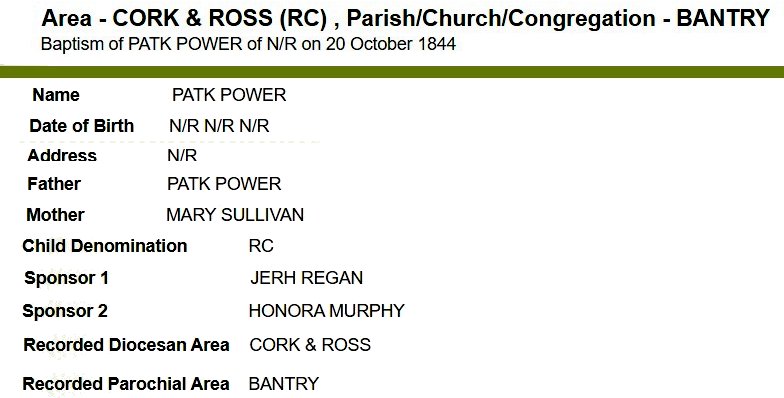
When he was four years old, his mother and father died, and he was brought to the United States by his older siblings. He was mentored by Father James Fitton, the pastor of Most Holy Redeemer Church in East Boston. He attended the Petit Seminary in Laval, Quebec and Saint Joseph’s Provincial Theological Seminary in Troy, New York, He was ordained a priest in the Cathedral Chapel of the Holy Cross by the Bishop of Boston, the Most Reverend John Joseph Williams on September 7, 1867, the eve of the feast of the Nativity of the Blessed Virgin Mary. The academic year of 1867-1868 found Father Power at the University of Louvain, Belgium where he studied canon law. Upon his return to the United States, he was assigned to parishes in Springfield and Chicopee, Massachusetts. When he left Springfield, after only six months, the parishioners presented him with a gold watch valued at $275, an amount equivalent to over $5,000 in today’s dollars. This gift was a measure of the esteem the parishioners had for the holy priest. However, Father Power’s constitution was always frail and in Chicopee he became seriously ill. He was moved to his brother, John’s home in the Fairmount Hill section of Brookline Massachusetts, where he died at age 25, on December 8, 1869, the Feast of the Immaculate Conception
Pilgrims have visited Father Power’s grave through the years, but in November 1929, sixty years after his death, prompted by an announcement by a local priest of a miraculous cure, an estimated one million people visited his grave seeking healing. Many of their prayers were answered. Indeed, the Boston Sunday Post of November 24, 1929, published a list of 150 cures.
The onslaught of visitors in November 1929 forced the cemetery to close for three months and move Fr. Power's body to a quiter area in the cemetery.
typical photo
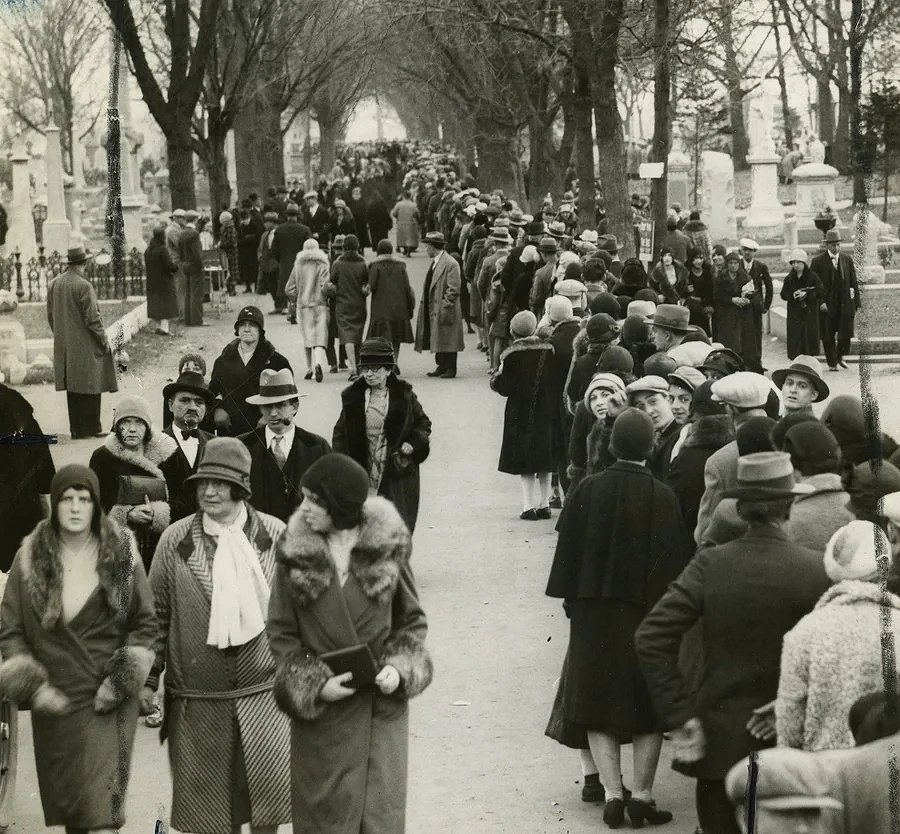
An interesting and informative summary was pinned by Bill Lombardi in the "Hometown Weekly" on July 18, 2018 and it is included hereunder:
The grave in Holy Cross Cemetery
By Bill Lombardi, Correspondent
Hometown Weekly, Newspaper, Medfield, MA
In October of 1929, the stock market crashed. Millionaires became penniless overnight as the Great Depression began. In the absence of welfare programs, poverty ran rampant. It was in this context that local eyes began turning to a cemetery in Malden.
In late October, 1929 it was rumored that miracle cures of the sick and lame were happening at the gravesite of Father Patrick J. Power, a Catholic priest who had died 60 years before, in Malden, MA. The local media picked it up and the crowds grew larger every day. On November 4, six-year-old James Panora of Revere, MA, a deaf mute since childhood, was brought to the grave by his mother. After praying, they stood up. When his mother spoke his named, he answered, "What?" She then asked him to say “Father Power,” and he repeated the words. Mrs. Panora became hysterical with joy, and several hundred people dropped to their knees in thanksgiving.
The following day, nine-year-old Vincent O'Neill of Somerville, who lost his eyesight through an illness, was brought to the cemetery by his grandmother. After praying at the grave, they went to the small nearby cemetery chapel. Within a few minutes, he cried out: "Grandma, I can see tall white people!” He was staring at the statues in the chapel.
In the first week, ten people afflicted with various diseases claimed cures. Someone who had a vision problem an their eyeglasses with a note attached saying: “Cured, thank you Father Power.”
More and more automobiles appeared at the Holy Cross cemetery. Trolley cars were jam-packed. Rope barriers had to be installed to keep the crowd in order. After kneeling and praying at the gravesite, they would go to the chapel and continue meditating. The ground began to erode as worshippers scooped up handfuls of precious dirt. They touched and kissed Father Power’s headstone. They stood in the rain and knelt in the mud.
Six-year-old William Graul of South Boston was brought to Boston City Hospital in a dying condition. After a coughing spell, his throat was so contracted that a rubber tube was inserted to help his breathing. The boy’s parents went to the cemetery and stood in line for two hours. When his mother finally reached the tomb, she dipped her handkerchief into a chalice, in which water had accumulated from a recent rainstorm. They rushed back to the hospital and she applied the handkerchief to her son's throat. At first, the nurse ordered her to stop. When she explained it had been dipped in the water at the shrine, however, the nurse let her proceed. Later that day, the doctor came in to check the tube and discovered the boy could now breathe on his own.
The events began to appear in the national newspapers. On Sunday, November 17, over 200,000 people flocked to the cemetery. More trolleys had to be added and hundreds of cars were parked all around the cemetery. Many had out-of-state license plates from Arizona, Florida, Colorado, and even as far away as California. Residents living nearby offered lodging for a fee. Outside the cemetery were hot dog and souvenir vendors. The Malden police had a difficult time keeping the overwhelming crowd in order, and asked for assistance from police departments in the surrounding towns.
The physically handicapped and mentally ill pleaded to reach the grave of Father Power. Families became separated from each other. Jack Sharkey, the heavyweight boxing champ, stood in line to pray for his three-year-old daughter, Dorothy, who was boar blind in one eye. Boston Mayor-elect James Michael Curley knelt in the drizzling rain with his wife to pray for her failing health. A woman from New York, who had claimed her right hand had been paralyzed for years, began writing the words Father Power for the crowd. People from all over requested that some of the earth be sent to them, which cemetery officials refused to do.
Cardinal William O’Connell made his second appearance to the cemetery. He refused to make any comment on the activities that were happening and declined to acknowledge that miracles had taken place. Vigil candles glowed throughout the night as thousands stayed to pray.
A man on crutches, who claimed he was from Pennsylvania and had been crippled for years, discarded them after praying. He kept yelling with joy that he was cured and could walk again. He told the crowd gathered around him that he needed money to get back home. Holding his hat out, they began to toss in coins. Suspicious, police noticed his bandage and crutches were brand new. They took him aside and after careful questioning, were convinced that he was a fraud. The police threatened to arrest him as a vagrant if he didn’t leave the cemetery.
There were other cases in which people claimed cures, but witnesses who knew them verified that they never had any afflictions. Now it was becoming a circus. People were discarding their crutches. The paralyzed could walk, the deaf could hear, the mute could speak, and the blind could see. Many cars were reported stolen and also wallets, pocketbooks and purses.
On November 24, Cardinal O’Connell ordered the cemetery closed and the gates were locked. Only those in funeral processions were permitted inside. Father Power’s body was exhumed and moved to another site. A high, six-foot iron fence was erected to protect the grave from being disturbed. No one was allowed to stop at his grave.
People traveling from all parts of the United States were unaware that they would not be allowed to enter the cemetery. When they arrived, they found policemen stationed at every entrance. Heartbroken and disappointed, they knelt on the sidewalk facing the grave only 300 yards away and prayed. As time passed, people lost interest and the gates were reopened. From November 3 to November 24, it was estimated that a million people had visited Father Power’s grave.
After researching the story, I wanted to find out if there were any actual cures. It’s been a long time, but I was still able to locate a few distant relatives. One refused to talk to me, and another refused to reveal if there was an actual cure. I did talk to the sister of James Panora, the deaf mute who spoke Father Power’s name. She informed me that though she hadn’t been born at the time, as far as she could remember, her brother was always able to mumble a word or two.
It has been almost 90 years, and people continue to visit Father Power’s grave. It is protected by the fence and visitors toss coins onto the grave, making it not only a shrine but a wishing well.
Whether there were any actual cures is unknown. What is more important is that this extraordinary religious event had brought a million health-seekers together in prayer and hope.
Father Patrick J. Power was born in Bantry, County Cork, Ireland, on October 20, 1844. he came to the United States and studied for the priesthood at St. Joseph’s seminary in Troy, NY. He was ordained at the Holy Cross Cathedral in Boston and served at the Holy Redeemer Church in East Boston. He loved to walk in the rain and it is believed that while recovering from an illness, he contacted pneumonia during one of his walks. On December 8, 1869, the Feast of the Immaculate Conception, he died at his brother’s house in the Fairmount Hill section of Brookline. He was only 25 years old.
BIO: Bill Lombardi is a U.S. Marine Corps veteran. He is the grandfather of Emily, Ashley and Zachary Sullivan, and Cayce and Jimmy Lombardi - all Walpole residents.
Transcript from an unnamed newspaper:
PRIEST'S BIRTH, DEATH MARKED
Fr. Power's Anniversaries Today - Little Is Known Of Early Life
BORN IN IRELAND; ORPHANED WHEN 4
Today is the anniversary of the birth and death of the Rev. Patrick J. Power whose grave in Holy Cross cemetery drew more than 1,000,000 pilgrims seeking cures last month.
Had Cardinal Connell not banned the public from the cemetery pending a church investigation of the reported cures, today probably would have seen the largest crowd ever to participate in a religious pilgrimage. Possibly the throng would have been even greater than any group of crusaders of the middle ages.
Facts about the life of Fr. Power who died when he was 25, only two years after his ordination, are meagre.
He was born in Bantry, County Cork, Ireland, a son of Patrick and Mary Power. His parents died when he was four years old.
An elderly brother John Power brought him to this country. There are extremely few facts about his boyhood extant.
William J. Cahill of 47 Royal street, Allston, recalls serving as altar boy many years ago with a boy named Patrick Power at the Holy Redeemer Church in East Boston. Mr. Cahill is more than 80 years old.
At that time Rev. James Fitton was rector at the East Boston Church. Fr. Fitton made a practice of educating worthy boys and it was through his guidance that many of them decided to study for the priesthood.
Fr. Power studied at Laval University in Quebec and in St. Joseph's Seminary at Troy, N.Y. From all reports he was an exemplary student.
He was ordained by Archbishop Williams in this city in 1867. He died in Brookline Dec. 8. 1869.
During his life he was unknown and unsung. For years a few Catholics knew that cures had been reported at Fr. Power's grave in Holy Cross cemetery. Malden. The rush to the grave, however, did not begin until November, last, when newspaper stories told of cures reported at the grave.
typical scene
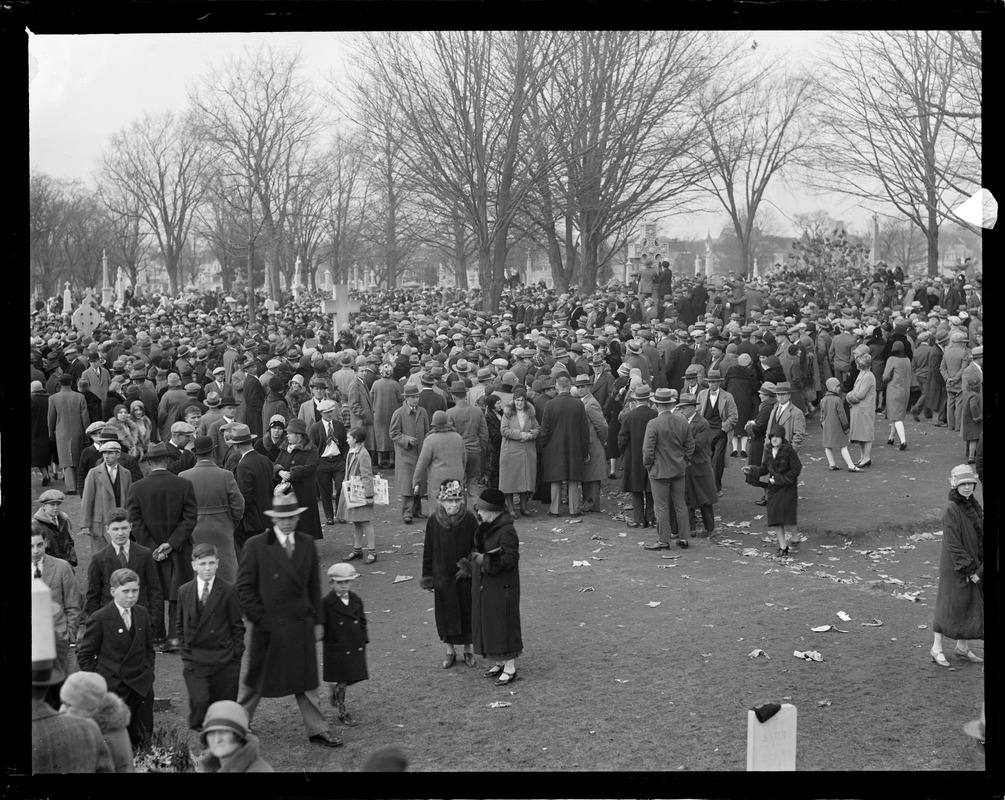
Transcript from an unnamed newspaper:
BODY OF PRIEST LAID AT REST IN SPECIAL GRAVE
Thousands Sought Miraculous Cure at His Sepulchre
By Associated Press
MALDEN, Mass., Dec. 14 - The body of the Rev. Patrick J. Power, to whose grave hundreds of thousands of persons came recently to seek miraculous cures, lay today in a specially prepared grave in front of the cemetery chapel.
Only priests, cemetery officials and police attended the transfer yesterday. Cardinal O'Connell, of the Bos-ton archdiocese ordered the cemetery closed to all except funerals on November 23 to permit the Roman Catholic church to make an investigation.
In a wooden casket in which it had rested for 60 days, the body was taken from the grave to the chapel for a brief service. It then was placed in the new cement-lined grave about which is a seven-foot wire fence.
The pilgrimages started last fall following reports that a Boston cripple had prayed at the grave and been cured.
On one Sunday 200,000 came and on two other days crowds of 100,000 gathered. Many remained overnight.
typical photo
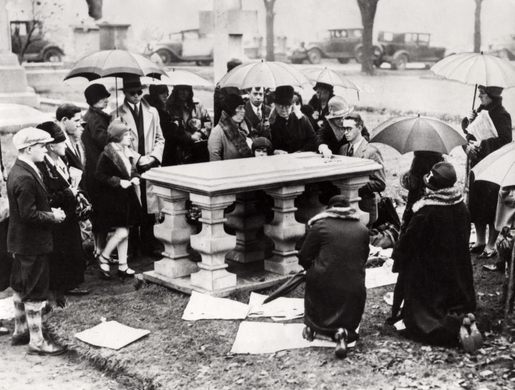
The following four images have been kindly provided by Mr. Charles Radosta, to whom BMD notices is greatly indebted.
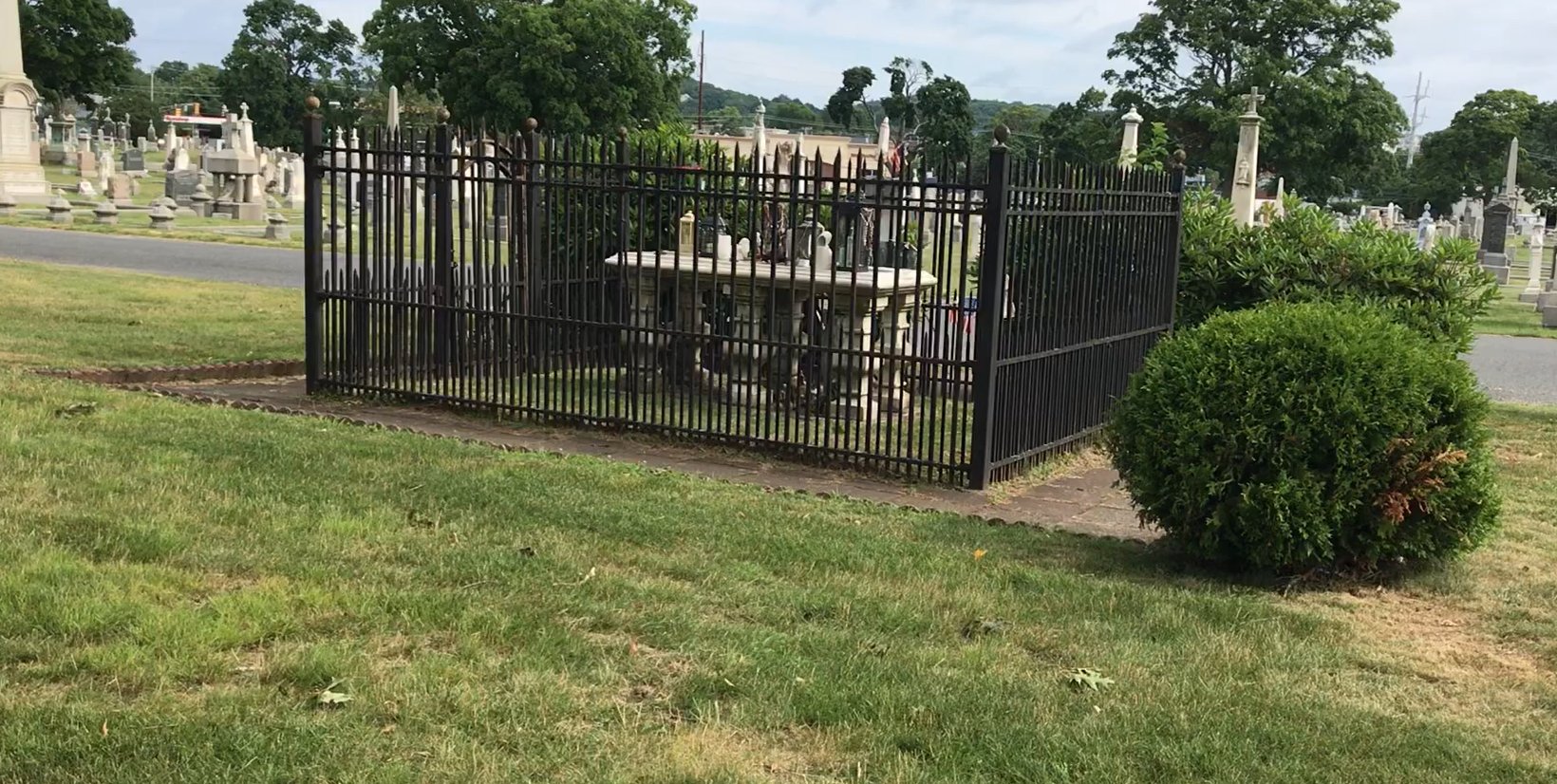
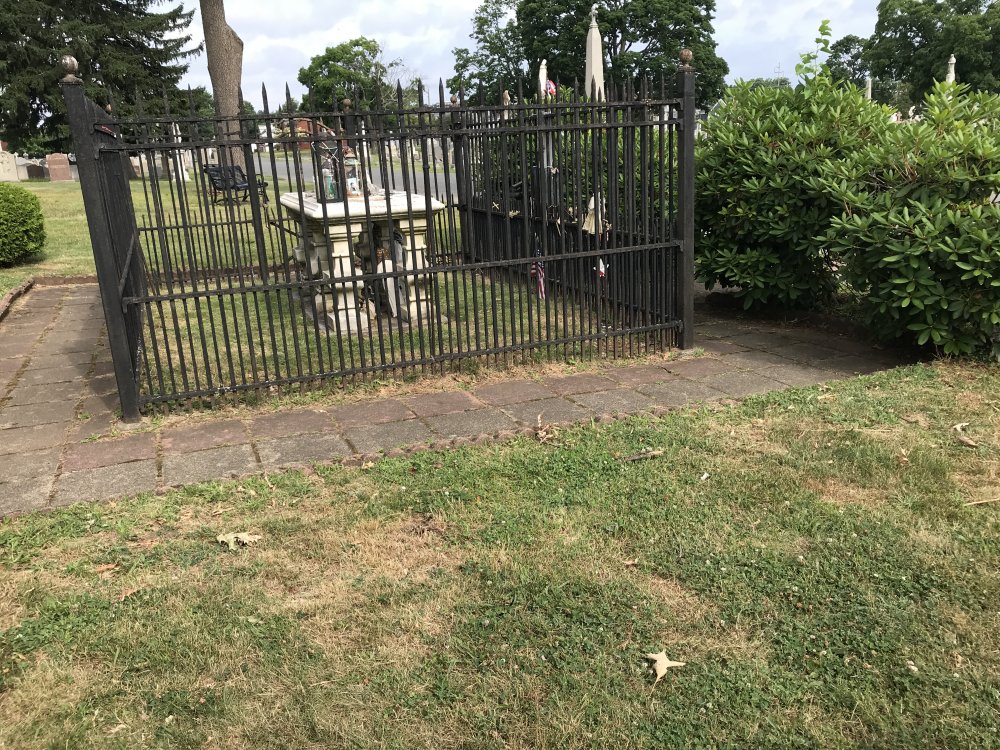
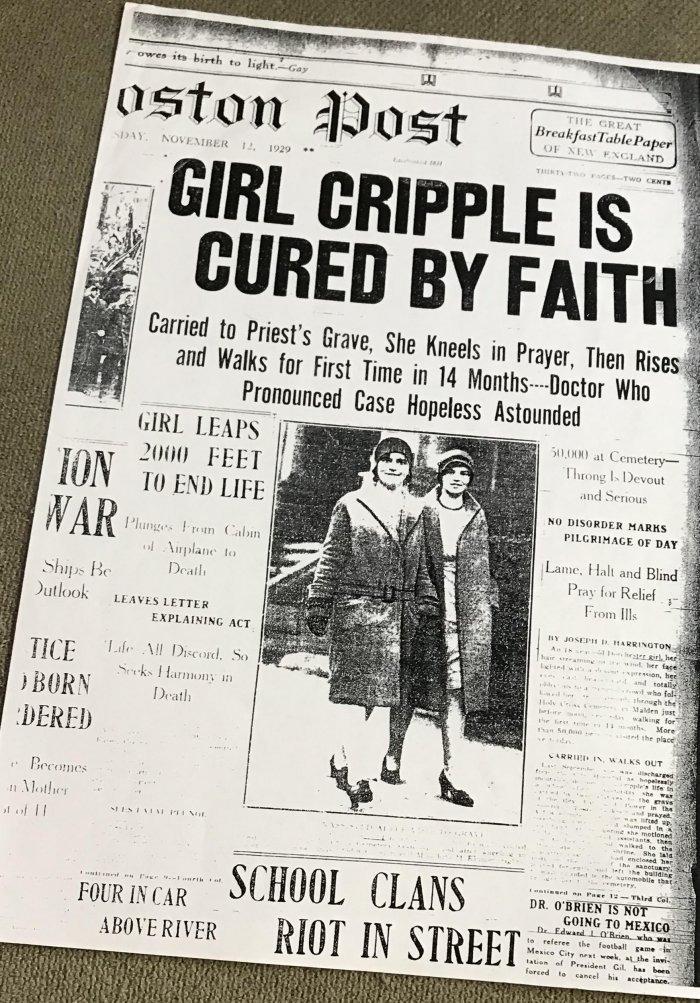
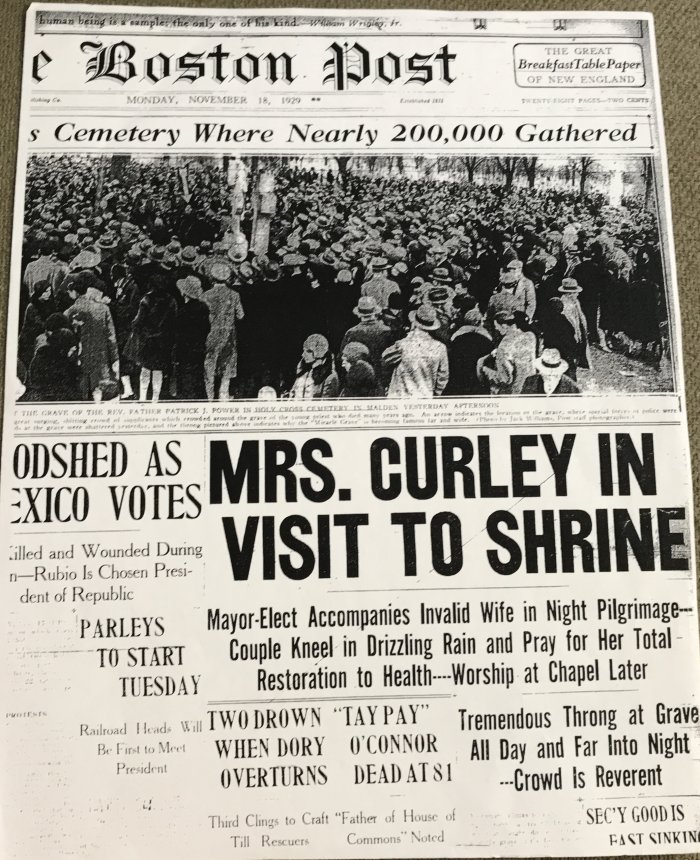
Transcript from The Boston Herald of Friday Nov 8, 1929 page 15
REPORT MORE CURES AT SHRINE
Over 25,000 Persons Visit Priest's Grave in Malden During Day
CEMETERY IS KEPT OPEN ALL NIGHT
Approximately 25,000 persons yesterday made pilgrimages to Holy Cross cemetery, Malden, the largest number on any day since the first reports were made public of miraculous cures at the grave of the Rev. Patrick J. Power. More cures or partial cures were reported yesterday than on any previous day.
From early morning they streamed through the gates, the curious and the believers, the crippled and blind, the deaf and dumb, those afflicted with various other forms of ailments, and those in good health who came to pray that some one dear to them and who lay on a sick bed, might be cured.
A detail of policemen was present to keep the crowd from lingering at the priest's grave, which now has taken on the importance of a shrine; a man was assigned to care for the thousands of vigil lights, small sacred candles which the visitors had placed in All Souls chapel on the hill overlooking the shrine.
And when sunset approached, end to the visitations, the cemetery officials decided that the cemetery should be kept open all night, so that none might be disappointed. Up to last evening it was always closed at 6 P. M.
Twice during the day some one looted the boxes, containing money offerings for the candles which were used as vigil lights in the chapel. The offerings there are to be used for a new St. Joseph's Church in the Maplewood district of Malden.
Many cures were reported, including that of 5-year-old James Panora of 31 McKinley street, Revere, who had been deaf and dumb since birth. He and his mother, Mrs. Anna Panora, visited the chapel in the afternoon and then went to the priest's grave.
They knelt and prayed and when they arose Mrs. Panora said, "Jimmie." The boy turned toward her and said, "What?" She then told him to say "Father Power," and after he had repeated the words, she became hysterical. She soon became calm, however, and she and her son and several hundred persons at the grave joined in prayer of thanksgiving.
typical scene
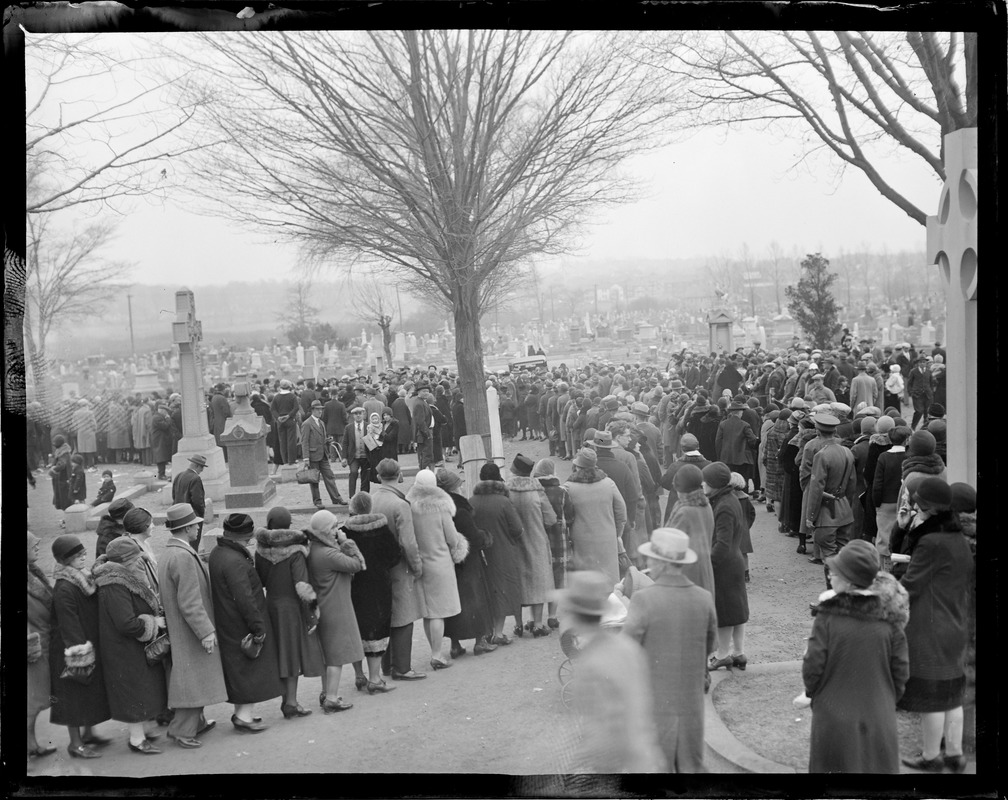
Newspaper cuttings
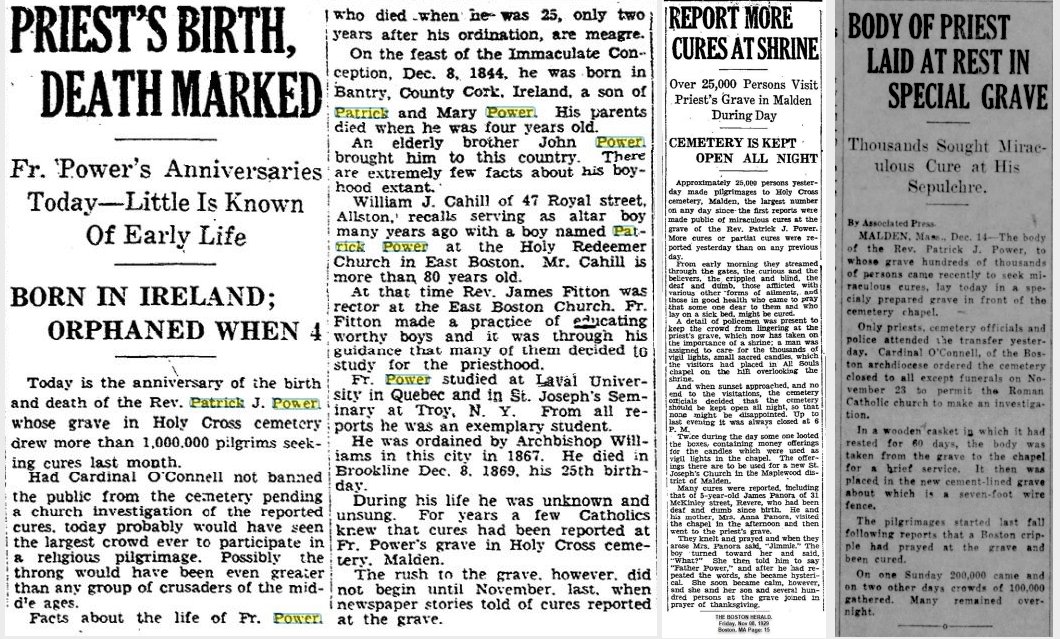
Some additional information
"Healing Power" film:
From https://tradcath.proboards.com/thread/1652/miracle-priest-fr-patrick-power?page=1 we include some extracts:
Pilgrims have visited Father Power’s grave through the years, but in November 1929, sixty years after his death, prompted by an announcement by a local priest of a miraculous cure, an estimated one million people visited his grave seeking healing. Many of their prayers were answered. Indeed, the Boston Sunday Post of November 24, 1929, published a list of 150 cures.
Healing Power is the story of the faithful who visited the grave of Father Power in 1929 and those who still visit his grave. They come to visit the grave of a priest who served only two years after ordination 150 years ago.
"Healing Power" was conceived by Victor Jenacaro, the step-son of the grand-nephew of Father Power. When his step-father died in 1955, Victor came into possession of two volumes of class notes that Father Power had written in Latin and French while attending the Petit Seminary in Quebec. Victor preserved these volumes for 55 years and in June 2010, presented them to the Most Reverend Robert Francis Hennessey, Auxiliary Bishop of Boston, so that they could be preserved in the Archives of the Archdiocese of Boston. Victor, however, felt called to do more to spread the knowledge of the life of Father Power and commissioned Larry Cappetto, a talented independent film maker to produce the film which became Healing Power. Larry is renowned as the producer of numerous documentaries.
Sandy writes: (Jan 17, 2021). - My stepfather Victor Jenacaro was the stepson of Harold Power, who was the grandnephew of Father Patrick Power. My stepfather had two books he inherited from his stepfather Harold Powers, to quote my dad in his letter to me about this.. “While in school Father Power wrote two books by hand in beautiful penmanship. One book was 800 pages written in perfect Latin, the other 1,200 pages written in perfect French. Harold Power passed away in 1955“. He then told me he kept these books for 50 years and then donated them to the archdiocese in Boston.
To quote him in his letter “In 2008 I decided to donate the books to the Archdiocese in Boston. I have attended his grave many times and amazed to see that 140 years after his death and 60 years of the incident at the cemetery in 1929 there were till well over 1,000 people visit his grave every month still seeking cures and healings. It was then that I decided to do Father Power's life story. I felt the whole world should know about this amazing priest who died at the very early age of 25. A film maker friend of mine and I completed the film after 18 months of interviews, scenes and the story of his life. I had the world premier of the film in Oct. 2009 at Boston College”.
The Shrine of Father Patrick Joseph Power
Published on the "EVERETT ADVOCATE" on 24 February 2017
EDITOR'S NOTE: Charles Radosta, the author of this story is a life-long resident of Everett. Mr. Radosta has been active in veteran, civic and fraternal organizations in the city. Over the past several years he has given talks on this story before various groups and organizations.alt
Father Patrick Joseph Power's grave at Holy Cross cemetery on Broadway in Malden.
On the morning of Friday, December 10, in the year 1869, almost 142 years ago, a horse drawn hearse, followed by a funeral cortege, slowly departed from the Holy Redeemer Church in East Boston. The weather was cold and the journey was difficult as the funeral procession travelled the next few miles to the cemetery. A two day storm had preceded the funeral and a foot of snow covered the ground. Finally the procession arrived in Malden, Massachusetts and entered Holy Cross Cemetery. The attendants gently removed the casket from the hearse and placed it over the open grave. Family, friends and clergy gathered around and joined in the final committal prayers. Amid the weeping, the tears and the sorrow, the casket was lowered, and the workmen took the excavated earth and filled the grave. As the mourners left the grave of Patrick Joseph Power, little did they know that his name would be revered on the lips of a million souls some 60 years later.
Patrick Joseph Power was born in the year 1844, in the little farming community of Bantry, about sixty miles southwest of Cork, in the country of Ireland. At the time of his birth Ireland was under the cruel domination of the English.
Land ownership was restricted, farmers were penalized, and their farms were divided. In order to survive they sold their livestock and what little grain their farms could produce. By the early 1840's half the Irish population was depending entirely on the potato for nourishment. The year following Patrick's birth, the small nation had to endure more misery. The potato crop was ruined by a devastating disease. Their main source of food and nutrition was destroyed. The suffering endured was exacerbated the following year. Disease destroyed the crop again. Food was scarce and starving people looked for aid. The British government gave only token relief, and watched as over a million people died of starvation, deprivation and disease. Patrick Joseph Power was only a year old at the time of the great famine. By the time he was four years old, both his parents had died and he was an orphan.alt
Almost a century after the sensation at Father Patrick Joseph Power's now fenced in grave, locals and travelers are still leaving offerings at the site.
A few months after his fourth birthday, young Patrick in the care of an older brother and sister, left Bantry and traveled to the village of Castletown on the Irish coast. There they boarded a large British sailing ship and along with seventy other passengers, left the country of their birth and sailed across the Atlantic to the United States of America. Five weeks later, after a long uncomfortable journey, the ship arrived at the Port of Boston and anchored at the new Deer Island facility. The following day after a physical inspection by the port physician, the passengers were discharged, left the ship, and entered the United States to begin a new life. During his early years, Patrick lived in East Boston and served as an altar boy at the Holy Redeemer Church, located on Maverick Street. The Pastor of that church, Father James Fitton, was a missionary priest. During his ministerial career, Fitton traveled extensively throughout New England. He established churches in Connecticut, Rhode Island and Massachusetts.
While pastor of a church in the town of Worcester, he established a school for the education of young men. Over the years this institution has thrived and expanded and is now known as the College of the Holy Cross. Father Fitton was a great influence in the life of Patrick Power. He was an eager student, anxious to learn. Fitton became his mentor. He taught him Latin, the Greek language and the literary classics. It was obvious that Patrick was impressed with Fitton. He decided to become a Priest.
He was nearly 17 years old when he began his studies for the priesthood. Six years later at the age of 23, he was ordained to the priesthood at the holy cross cathedral in Boston. Following his ordination he studied canon law for a year and then began his ministry. Shortly after his ministry began, Father Power became ill. He was very frail, and his health was failing. Consequently, he could not continue his ministry and went to the home of his sister Mary, The sister who brought him to America. His health continued to decline.
He was then taken to Brookline. He was now bedridden and his condition was serious. Finally the disease that wracked his body, took its toll. Father Patrick Joseph power died at the home of brother on December 8, 1869. The death Certificate in the Town Clerk's Office in Brookline recorded the official cause of death as tuberculosis. Patrick Joseph Power, who was born in Ireland during a time of brutal oppression, migrated to the United States and was ordained a priest in the Roman Catholic faith, died at the age of 25, and was buried at Holy Cross Cemetery in Malden. The cemetery, owned by the Archdiocese of Boston was opened the year before his death. There is a special area in the cemetery reserved for priests and nuns. Father Power was the first priest buried in that section. Not long after his burial a monument was placed over the grave.
The monument is a white marble tablet, six feet long by three feet wide. The monument is supported several feet above the grave by six pedestals. Carved in the marble at the head of the tablet is a chalice. Many persons have researched his life and could not find any extraordinary incident or event. Nothing has ever been discovered that would lead to the extraordinary events that occurred after his death. Shortly before the turn of the century stories began to surface about the grave of Father Power.
It seems that persons passing the grave would dip their fingers in the rain water collected in the chalice. The chalice resembled a holy water font and people would bless themselves, as they might do upon entering a church. According to one reliable source, an incident occurred shortly before the turn of the century in the year 1897. A man suffered a painful injury, when a metal spike was accidentally driven into his leg. A friend attempting to remove the spike tore the flesh and gangrene set in.
The man's sister anointed his leg with water from the grave. There were several applications and slowly the leg began to heal. Over the course of the next 30 years other cures were associated with the tomb. A deaf boy was made to hear. Stories were repeated. For years these stories intensified, but were never publicized. Holy Cross Cemetery is within the parish boundaries of St. Joseph's Church on Salem Street in Malden. On October the 27th, 1929, the Sunday proceeding All Saints' Day, the Pastor of that Church, Father Patrick Walsh, gave a sermon. In his sermon he referred to stories about the grave of Father Power, and mentioned that many saints must be buried in Holy Cross Cemetery. He included a request for information about any miracles or cures to persons visiting the grave. This sermon was repeated throughout the parish, and beyond. Once again stories of the grave began to surface. One of these alleged cures was reported by Mrs. Mary O'Hearn of Franklin Street in Everett. Mrs. O'Hearn was the mother of five children, and for years was a victim of deafness. She had been examined by several doctors and her deafness was diagnosed as incurable.
In desperation Mrs. O'Hearn went to the grave on several occasions. Each time she blessed herself and prayed. The morning after her third visit, she got out of bed, and realized something had changed. She began to cry. A miracle had occurred. Her hearing had been restored.
This miraculous event was told, and retold. Soon it was reported in the media. One by one, newspapers printed front page stories about holy cross cemetery and the wonders and miracles of this grave. The publicity created a tidal wave of humanity. It was a trickle that became a stream. A stream that became a river and a river that became a flood. The multitude was measured First by the tens, then by the hundreds, and then by the thousands. The first of the great crowds came on Sunday, November the third.
The Malden evening news reported that people came as early as six in the morning. By noon the numbers stood ten deep at the grave. On the following Sunday, November the tenth, over 100,000 persons came to visit the grave. Thousands and thousands more came during the week.
On Sunday, November 17, over 200,000 people crowded Holy Cross Cemetery. As the crowds multiplied the newspapers increased the size of their headlines. Day by day, hour by hour, a constant stream of sick and suffering humanity poured into Holy Cross Cemetery.
The total number of visitors was estimated at almost a million. Cures were reported virtually every day. The Boston Sunday Post of November the 24th, 1929, published a list of 150 names and addresses of those who claimed to be cured. Cripples abandoned crutches. Canes and braces were discarded. The blind could see, the deaf could hear, the dumb could speak. Newspapers reported the scene around the cemetery. Every trolley car packed to suffocation. Every street crowded with cars. At a time when motor vehicle traffic was not significant, Broadway all the way from the cemetery to Glendale Square in Everett was bumper to bumper with traffic. Even more dramatic was the scene inside the cemetery. Police organize crowds into lines. As they approach the grave, the line divides, passing the grave on each side.
Money, flowers, rosary beads and religious pictures cover the grave. AFTER PASSING the grave, the line continues slowly toward the chapel. Hundreds anxiously wait to enter the building. They make their way slowly, up one side aisle, before the altar, and down the opposite aisle. They pause to genuflect, to pray or to light a candle.
Back at the grave the unending surge of humanity continues. Mental patients, victims of accidents and the afflicted appear hour after hour, from dawn until far after sunset. Men fill their pockets and women fill their pocketbooks with earth from the grave. Every day the cemetery receives hundreds of letters from all over the world asking for a handful of earth, a vial of water or some object associated with the grave. Pilgrimages to the grave of father power became a spectacular event. One day, eleven busloads of pilgrims came from Springfield. Among the passengers were 70 cripples. The Archbishop of Boston, William Cardinal O'Connell visited the cemetery on two occasions. Each time he observed with minute detail what was happening before his eyes.
The Mayor of Boston, James Michael Curley, came to pray for his wife, who was an invalid. The widow of a former governor came to pray for her sister, who was seriously ill. In never ending numbers, individuals and groups of pilgrims stormed Holy Cross Cemetery. Local police, state police and even firemen were called to control the situation, but the situation was getting out of control. The huge crowds, the desecration of nearby graves, and the volume of traffic, became a matter of great concern. Finally on November 23, Cardinal O'Connell ordered the cemetery closed to all visitors. Police were posted at the gates, and no one was allowed to enter.
The ecclesiastical authorities agreed that changes had to be made, before the cemetery could re-open. The grave of Father Power was situated too close to other graves. It was extremely difficult to prevent the public from encroaching on nearby graves. Consequently, the ecclesiastical authorities decided to move the remains of Father Power to a more secluded area.
Several weeks later with a dense fog blanketing Holy Cross cemetery, and a heavy rain falling at intervals, the remains were removed from the grave and buried again in a new location. Although the public was not allowed, the change of graves was witnessed by the State Police, cemetery officials, and members of the clergy. Shortly afterwards an iron fence was erected around the grave and the monument. Because the cemetery was closed, and because of the frigid weather, the huge crowds began to dwindle. Police and state troopers continued to guard the cemetery, day and night. Only funerals were allowed to enter the cemetery. This continued all during the winter months, until the following spring. Then on April 3 of 1930, the Cardinal went to the cemetery, visited the grave, inspected the area and gave permission to re-open the cemetery. He called a press conference to announce the opening. He asked the media to refrain from any sensational publicity. He did not want a repetition of the huge crowds, and he emphasized that this was not a circus or a carnival.
In spite of this, almost 5,000 persons came the following weekend to visit the grave. The grave, moved to a new location, was now surrounded by an iron fence. Visitors could see, but could no longer touch the monument. As time Passed, the crowds dwindled, the police were removed, and it was no longer reported in the news media. To this day the church has never recognized any of these cures or miracles, and has left its members free to believe or reject them. Although the majority of pilgrims were Catholic, it must be emphasized that people of many other faiths prayed at the grave. Many of the cures were investigated and many reasons were given. Devout Catholics believed that God was present. Then there were those who were reluctant to accept a supernatural cause for these events. Also there were those who said that most of the persons in the mighty throngs of those twenty two days were relatively uneducated. Yet many of the worshipers were people of wisdom. There was the Mayor of Boston, a well known judge from the state of New York and the former heavyweight boxing champion of the world, Jack Sharkey. Doctors testified to the miracles of their incurable patients.
Others scoffed and said that many paralytics suffer only from hysterical paralysis. If once a victim of many such troubles makes up his mind to get better, he gets better, unless he has an incurable disease. Many long years have passed since those eventful days in November of 1929. The Chapel in Holy Cross cemetery, where thousands once prayed, has been demolished. The memory of the crowds, the headlines, and the publicity of the shrine is known to only a few. Yet, there is undeniable evidence that many people still visit the grave of Father Patrick Joseph Power. Today as you enter the main entrance of Holy Cross cemetery on Broadway, and proceed straight ahead, you will come to the grave. Behind the grave, the landscape rises gently to the top of a knoll. On this knoll once stood the majestic wooden chapel, the sanctuary where thousands came for comfort and prayer. Beyond the grave is the area reserved for the anointed, the bishops, priests and nuns of the Roman Catholic Church. Their lives commemorated with crosses, stone and bronze.
In front of the grave a small path leads to the iron fence surrounding the monument and the tomb. The panarama, the stillness and the reverence instill a sense of awe. You wonder if this is hallowed ground. Does this grave have a supernatural presence? Does this grave of a young Catholic priest invoke divine intervention? These and other questions remain. But one thing is certain; time has not erased the legend of this shrine. There are many who still come and the evidence is compelling. Crosses, rosary beads and religious medals cover the fence and the monument. The grave of Father Patrick Joseph Power, a source of comfort and hope to those who are troubled, a Shrine that is sacred to those of great faith, and a legend that will live in perpetuity.
Note by Frank: In the above article it stated that Patrick with an older sister and brother departed from Castletown. Interesting that the fishing port is referred to as Castletown as this is the name used generally in that area but as Castletownbere outside of the Beara penisula. Acturally you may occasionally see the full name used which is Castletown-Berehaven, or just Bearhaven
2 minute video url on YouTube
https://youtu.be/r_-bGZgCyfQ
Location of Fr. Power's grave in Holy Cross Cemetery in front of Chapel
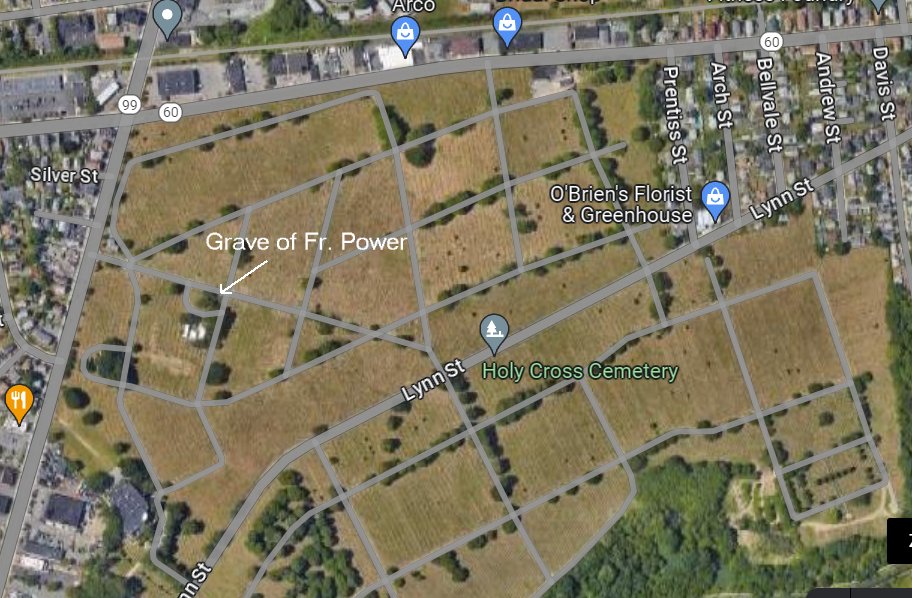
Image from Google
